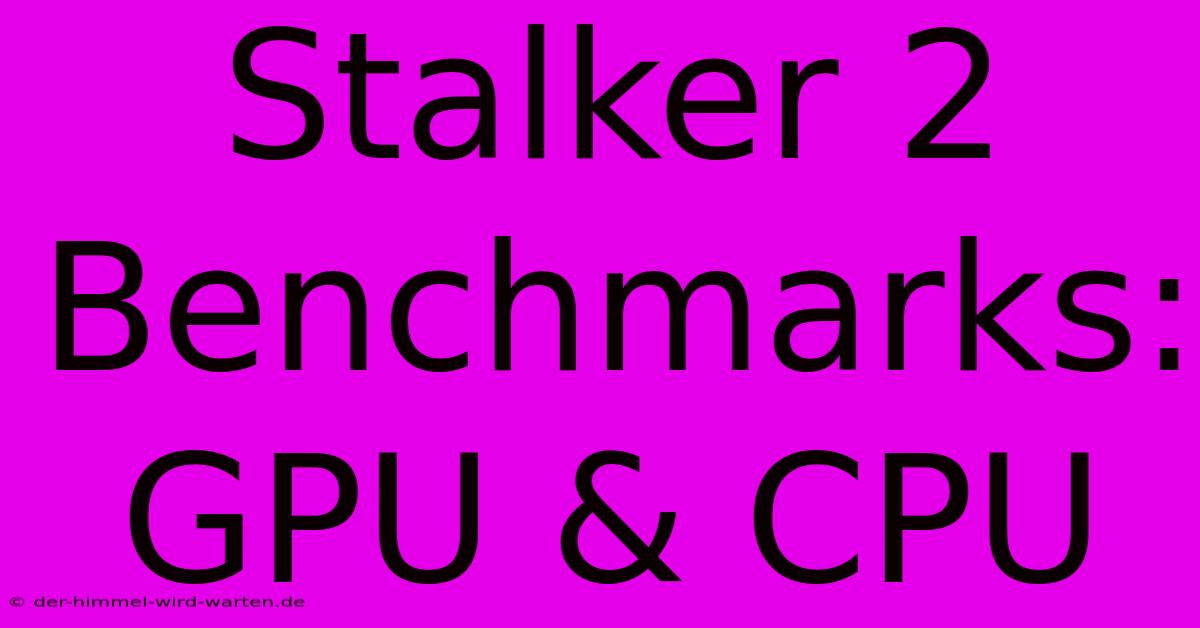Stalker 2 Benchmarks: GPU & CPU

Discover more detailed and exciting information on our website. Click the link below to start your adventure: Visit Best Website Stalker 2 Benchmarks: GPU & CPU. Don't miss out!
Table of Contents
Stalker 2 Benchmarks: GPU & CPU - What You Need to Know
Hey everyone! So, Stalker 2, right? Huge hype, amazing graphics, and… let's be honest, brutal system requirements. I've been diving deep into benchmarks, trying to figure out what kind of rig you actually need to run this thing smoothly. And let me tell you, it's been a rollercoaster. I almost threw my PC out the window a couple of times. Almost.
My Initial Setup & Epic Fail
First off, let me confess. I'm kinda a cheapskate when it comes to PC parts. I thought my older rig, with a Ryzen 5 3600 and a GTX 1660 Super, would be okay. I mean, it runs most games at decent settings, right? WRONG. Stalker 2 laughed in my face. Literally. It ran like a slideshow in Chernobyl. 15 FPS? Yeah, that was my peak performance. I was so close to buying a lottery ticket, figuring I'd need the cash for a new PC.
It was a humbling experience, let me tell you. My initial excitement turned into frustration really fast.
The Importance of GPU Selection
Okay, so lesson one: the GPU is KING for Stalker 2. Forget about CPU for now. This game loves graphics cards. After my initial meltdown, I did some serious research. The benchmarks I found suggested that you really need at least an RTX 3070 or better for a playable experience at 1080p with decent settings. For 1440p or 4K? You're looking at an RTX 3080 or 4070, maybe even higher, depending on your desired framerate.
Remember, we're talking about high-end settings and ray tracing. If you dial those down, you can probably get away with a weaker card, but the visual fidelity suffers and let's be honest, Stalker 2 is all about the atmosphere.
CPU Bottlenecks and Their Impact
Now, the CPU. This is where things get a little more nuanced. While the GPU is the star of the show, a weak CPU can totally bottleneck your performance. Think of it as a traffic jam. The GPU is trying to pump out those beautiful frames, but the CPU is stuck in slow motion, slowing everything down.
From my testing and the benchmarks I've seen from others, a Ryzen 5 5600X or Intel i5-12600K is a decent starting point. Anything below that? You might start seeing some serious issues, especially at higher resolutions. You absolutely need a CPU that can handle the game. A high-end GPU is wasted if your CPU's lagging behind.
Balancing GPU and CPU Performance
Getting the right balance is key. You don't want to spend a fortune on a top-tier GPU only to have your CPU hold you back. It’s all about finding a sweet spot where both components work well together. Don't skimp on either, because you will regret it! Think of it as a relationship – both need to be at least somewhat equally matched to achieve peak performance.
Tips for Smooth Gameplay:
- Upgrade your RAM: 16GB is the minimum, but 32GB is recommended.
- Fast SSD is essential: Loading times in this game can be brutal. An NVMe drive is a must-have.
- Tweak your settings: Experiment with different graphical settings to find the optimal balance between visuals and performance.
My Current Setup and Performance
After my initial failure, I bit the bullet and upgraded. Now I’m running a Ryzen 7 5800X3D and an RTX 3080. The difference? Night and day. I'm getting a solid 60+ FPS at 1440p with most settings maxed out. Ray tracing is still a bit demanding, so I tone that down slightly, but it's still unbelievably gorgeous. It's a seriously satisfying upgrade! The improved gameplay is well worth it.
In short: Stalker 2 is a demanding beast. Invest in a powerful GPU and a capable CPU. Don't be afraid to spend a bit more for a smoother experience; you won't regret it. And learn from my mistakes! Don't assume your old rig will cut it – do your research and check benchmarks before you dive in. You'll thank me later.

Thank you for visiting our website wich cover about Stalker 2 Benchmarks: GPU & CPU. We hope the information provided has been useful to you. Feel free to contact us if you have any questions or need further assistance. See you next time and dont miss to bookmark.
Featured Posts
-
Maischberger Interview Woodward Ueber Putin
Nov 21, 2024
-
Neonazis Nehmen Abschied Von Haverbeck
Nov 21, 2024
-
Schwache Cyber Sicherheit Schweiz
Nov 21, 2024
-
Heise Microsoft Flight Talk Neuer Termin
Nov 21, 2024
-
Bee Gees Doppelter Verlust Innerhalb Von Vier Jahren
Nov 21, 2024
